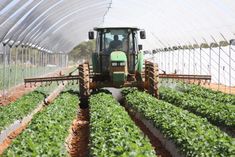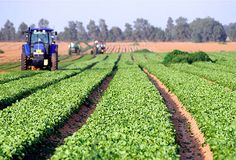Mediterranean Agriculture
Mediterranean agriculture is a distinctive farming practice characterized by its adaptation to the climate of regions bordering the Mediterranean Sea, including Southern Europe, North Africa, and parts of California, Chile, and Australia. This type of agriculture has evolved to thrive in a Mediterranean climate, which features mild, wet winters and hot, dry summers. Key components of Mediterranean agriculture include the cultivation of crops like olive trees, grapevines for winemaking, wheat, and various vegetables.
Understanding Mediterranean Agriculture
Mediterranean agriculture is characterized by its harmonious relationship with the Mediterranean climate, which features mild, wet winters and hot, dry summers. This climate pattern is found in regions bordering the Mediterranean Sea, including Southern Europe, North Africa, and parts of California, Chile, and Australia.
Characteristics of a Mediterranean Climate

The Mediterranean climate, the cornerstone of this agricultural style, offers mild, wet winters and hot, dry summers. These conditions influence crop choices and farming practices. Also read about: What Is Business Finance
Crops Suited for Mediterranean Agriculture
Learn about the crops that thrive in this climate, such as olive trees, grapevines (for wine production), wheat, and various vegetables.
Common Crops in Mediterranean Agriculture
Mediterranean agriculture, as a testament to its adaptability to the region’s climate, is known for cultivating a variety of crops that thrive in the specific conditions of mild, wet winters and hot, dry summers. Some of the most common crops found in Mediterranean agriculture include
Olive Trees: The Mediterranean region is renowned for its olive production, making it a global leader in olive oil. Olive trees not only adapt well to the climate but are also deeply ingrained in the cultural and culinary traditions of these areas.
Grapevines: Grapes are cultivated for winemaking, and Mediterranean wine is celebrated for its unique flavors. The combination of sunny days and well-drained soils is ideal for grapevine cultivation.
Wheat: Wheat is a staple crop in Mediterranean agriculture, providing a vital source of sustenance in the form of bread and pasta.
Various Vegetables: The region also grows a range of vegetables, including tomatoes, peppers, eggplants, and zucchini, which are integral to Mediterranean cuisine.These crops not only thrive in the Mediterranean climate but also play a significant role in the culinary and economic landscape of the regions bordering the Mediterranean Sea.
Farming Techniques in Mediterranean Agriculture
Mediterranean agriculture employs several unique farming techniques that make it well-suited to its climate. Read about: Is Finance a Hard Major
The Role of Terracing
Due to the hilly and mountainous terrain in many Mediterranean areas, terracing plays a crucial role in maximizing arable land and preventing soil erosion.
Water Management and Irrigation
Discover how sophisticated irrigation systems are used to optimize water resources and maintain crop productivity in the face of water scarcity.
Sustainable and Traditional Practices
Mediterranean agriculture often incorporates traditional and sustainable farming methods, emphasizing the efficient use of natural resources.
Specialty Products: Olive Oil and Wine
Explore how this style of agriculture has led to the production of high-quality goods like olive oil and wine, becoming renowned worldwide.
Challenges Faced by Mediterranean Agriculture

While Mediterranean agriculture has flourished for centuries, it is not without its challenges.
Learn how modern farmers are adapting to climate change to sustain their crops and livelihoods.
The Cultural Significance of Mediterranean Agriculture
Mediterranean agriculture extends beyond the fields and farms; it is deeply intertwined with the culture and history of the regions it sustains. The practices, crops, and traditions associated with this style of farming have left an indelible mark on the identity of these areas.
The olive tree, for instance, has become a symbol of life and prosperity, and the production of olive oil is not just an industry but a way of life.
Families pass down the knowledge of caring for these trees from generation to generation, and olive groves often hold historical and sentimental value.
Similarly, the art of winemaking has become a centuries-old tradition in Mediterranean cultures. The grapes grown in these regions are not merely ingredients for wine; they are a representation of the terroir, embodying the essence of the land and its people.
Mediterranean agriculture also contributes to the rich tapestry of local cuisines. The vegetables and grains that thrive in this climate are the basis for Mediterranean dishes that have gained international acclaim. From Greek salads to Italian pasta, the influence of these crops is undeniable.
Furthermore, the terracing techniques, stone walls, and irrigation systems used in Mediterranean agriculture have left their mark on the landscape, creating picturesque vistas and preserving the historical character of the regions.
In essence, Mediterranean agriculture is more than a means of livelihood; it is a cultural heritage, a way of connecting with the land, and a source of pride for the people who call these regions home. It encapsulates the traditions, flavors, and landscapes that make the Mediterranean a unique and cherished part of the world.
Conclusion
In conclusion, Mediterranean agriculture is a unique and resilient form of farming that thrives in the face of challenging climate conditions. It is a testament to the adaptability and ingenuity of farmers in regions bordering the Mediterranean Sea.
FAQs
Q. What makes Mediterranean agriculture distinct?
Mediterranean agriculture is distinct due to its adaptation to a climate characterized by mild, wet winters and hot, dry summers.
Q. What are some common crops in Mediterranean agriculture?
Crops commonly grown in Mediterranean agriculture include olive trees, grapevines, wheat, and various vegetables.
Q. How do farmers manage water in Mediterranean agriculture?
Farmers often use sophisticated irrigation systems to optimize water use and maintain crop productivity.
Q. What challenges does Mediterranean agriculture face?
Challenges include water scarcity, climate change, and the need for adaptation to ensure sustainability.
Q. What is the cultural significance of Mediterranean agriculture?
It plays a vital role in preserving cultural and historical traditions in regions bordering the Mediterranean Sea.












